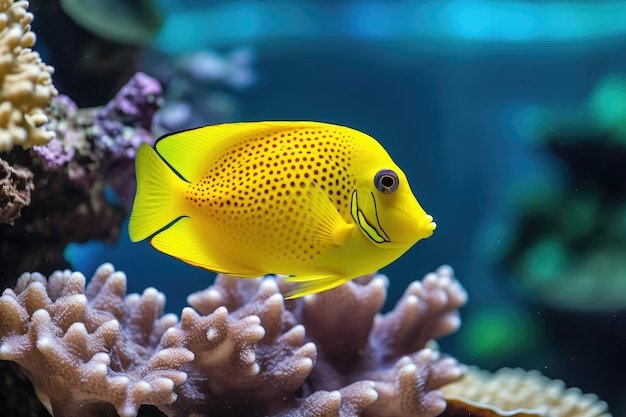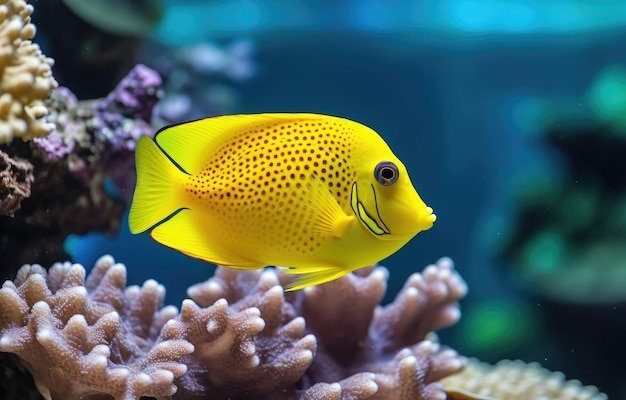
Understanding the Yellow Tang
First things first, let’s get to know the Yellow Tang. This vibrant fish is native to the warm waters of the Pacific Ocean. Known for their striking yellow color and distinctive body shape, they can grow up to 8 inches long. Yellow Tangs are part of the surgeonfish family, and they come equipped with a sharp spine on their tail—hence the name “surgeonfish.”
In addition to their beautiful appearance, Yellow Tangs are popular in the aquarium trade because of their algae-eating habits. They help keep your tank clean by munching on unwanted algae and contributing to a balanced ecosystem. However, they do have some specific needs regarding their habitat and tank mates.
Personality and Behavior
Yellow Tangs have lively personalities; they’re active swimmers that enjoy exploring their environment. They love to dart in and out of hiding spots and are generally quite social. However, this energy can sometimes lead to territorial disputes, especially in smaller tanks. If you put two Yellow Tangs in a confined space, they may fight for dominance, causing stress for both fish.
Also, consider their temperament when selecting tank mates. They can be a bit nippy toward slower or more docile fish. If you’re thinking about pairing them with corals, it’s essential to choose compatible species, as their lively antics can disturb delicate coral structures.
Are Yellow Tangs Reef Safe?
The short answer is yes, Yellow Tangs are often considered reef-safe. But it’s not always black and white. While they typically don’t eat corals, their behavior can cause issues. For instance, if they feel crowded or threatened, they may start nipping at the coral, which can lead to damage.
So, if you decide to introduce a Yellow Tang into your reef tank, make sure it’s adequately sized to accommodate their activity levels. A tank of at least 75 gallons is often recommended for a single Yellow Tang, providing enough space for them to swim and explore without intruding too much on delicate corals.
Choosing the Right Corals
Now that you know Yellow Tangs can coexist with corals, you might wonder which types are best suited for a tank with these lively swimmers. Generally, you’ll want to stick with corals that are more resilient and can withstand some playful nudging.
Here are a few coral options that tend to thrive in a tank with Yellow Tangs:
- Soft Corals: Types like Zoanthids and Mushrooms are generally more forgiving and can withstand some bumps.
- Hard Corals: Sturdy species, such as some SPS (Small Polyp Stony) corals like Montipora, can do well, but monitor closely.
- LPS Corals: Large Polyp Stony corals, like Frogspawn and Hammer corals, can be compatible, but they require careful placement.
Choosing the right corals can make a big difference in ensuring a peaceful coexistence.
Setting Up Your Reef Tank
Creating the ideal reef environment for Yellow Tangs can be crucial for harmony. First, assess your tank layout. It’s best to provide plenty of hiding spots using live rock, which offers both shelter and foraging opportunities. A well-structured tank will not only make your fish feel safe but also create an aesthetically pleasing environment.
You should also maintain stable water parameters. Yellow Tangs thrive in well-circulated water with good lighting and stable temperature. Aim for:
- Temperature: 72°F to 78°F
- Salinity: 1.020 to 1.025
- pH: 8.1 to 8.4
Regular water changes and monitoring the levels can help to keep both fish and corals happy.
Feeding Your Yellow Tang
Keeping your Yellow Tang well-fed is essential to minimize their interest in nipping at corals. They primarily thrive on a diet of algae, but don’t forget to vary their meals. A mix of high-quality marine flakes, spirulina, and fresh greens like nori can go a long way. Providing plenty of food can keep them busy and less likely to bother your corals.
You might be wondering if you need to feed them specifically to keep them from going after your corals. Honestly, a well-fed Yellow Tang is usually a happy fish, and a happy fish tends to be less aggressive towards other inhabitants in the tank.
Common Issues and Solutions
Even with the best setup, things can sometimes go awry. You might notice your Yellow Tang occasionally bothering your corals. Here are some common problems and solutions to keep in mind.
1. Nipping at Corals: If you see your Yellow Tang showing too much interest in your coral, try rearranging the tank or adding additional hiding places. This could help alleviate any feelings of territory squabbles.
2. Stress Factors: Ensure the tank is not overcrowded, as this can lead to stress and aggressive behavior. If you have other aggressive fish, consider removing one to help balance the dynamics.
3. Health Complications: Keep an eye out for signs of stress or disease like faded color or heavy breathing. Regular water testing and keeping a clean tank can help prevent many health issues.
Final Thoughts
Yellow Tangs can indeed be a lovely addition to a reef tank, bringing color and personality to your underwater world. With careful planning and attention to their needs, you can create a harmonious environment where both fish and corals thrive together. Just remember, it’s all about balance. Keep an eye on their behavior, choose suitable coral types, and maintain a well-structured tank. Before long, you’ll have a vibrant, lively reef that feels like a slice of the ocean right in your living room!

